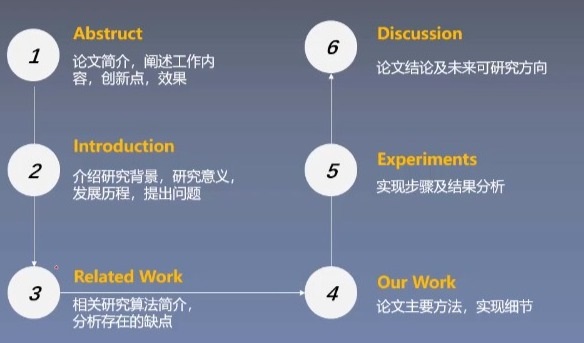首先阅读论文可大致分为三遍:
第一遍 5-10min(确认是不是值得第二遍)
-
目的:快速甄别论文质量及相关性
-
阅读标题,摘要(Carefully read the title, abstract)
-
阅读段落及其副段落标题,忽略其他(Read the section and sub-section headings )
-
阅读结论(Read the conclusions)
-
坚持2-8原则。真正有价值的论文总是很少,即便是领域内的文章------有选择性地选择2的文章。大部分文章不需要一字一句从头读到尾------有选择性地读文章内的2部分。
第二遍 1h以上
-
目的:一次性阅读完整篇论文,掌握这个论文的主要内容及其证明的论点(grasp the content of the paper and summarize the main thrust of the paper)。
-
阅读论文尽可能少做笔记查阅单词打断自己,实在不行查阅完迅速跳回来。要做笔记后面第三遍再做。(保持思路的连贯性)
-
阅读的过程中大脑会思考一些问题,不要忽视自己发现的问题,带着这些问题去读,不会盲目。
-
中学学习的英文阅读技巧都适用,比如每段的第一句就是本段的中心句。段落一般是总分总或总分结构。第一句话一定要理解,反而后面不是这么重要。
-
忽略证明的细节(ignore details such as proofs),仔细阅读图表和说明材料(Look carefully at the figures, diagrams and other illustrations in the paper)
是否有错误,标记出一些需要进一步阅读的参考材料(mark relevant unread references for further reading) -
读完这遍后,发现论文中很多不熟悉的术语和名字(terminology and acronyms),要不就是你缺乏对应的背景知识,要不作者的水平有限写的不够清楚。可以决定是否搁置一边,可以先阅读一些背景知识后再读或者直接放弃。
看完摘要,扫一下全文的图片和表格。最后再看Method!
第三遍
-
完全理解论文中内容,把自己当作作者,在同样假设的基础上,重新演绎一下论文里面内容,可以识别论文中提出的是否有创新性,识别隐藏的假设和缺陷,是否有逻辑问题。
(virtually reimplement the paper: that is, making the same assumptions as the authors, recreate the work. By comparing this recreation with the actual paper, you can easily identify not only a paper’s innovations, but also its hidden failings and assumptions) -
必须结合源码深入,很多东西仅看论文是很模糊的!
对不熟悉的领域,最快的办法是先看两篇中文综述了解。
文章结构
- Abstract:简洁明了的阐述本文的研究目的,方法,结果。——————五星
- Introduction: 宏观上指出领域内存在的问题,引出自己的work,辩论自己work的必要及重要性。diss别人-----证明自己工作的重要性。这部分可以看做Abstract的扩展。 ——————三星
- related work:中性地介绍领域的发展及别人的方法。 ——————二星(文献综述)
- Author’s work: 整个文章的核心 ——————五星
- Experiments/Ablations... : ——————三星(对实验结果的discuss很重要)
- Conclusion: ——————五星
阅读顺序:
第一遍:1 ( ightarrow) 6
第二遍:1 ( ightarrow) 2 {( ightarrow) 3} ( ightarrow) 4 ( ightarrow) 6 ( ightarrow) 5
加快阅读速度的方法:频繁划掉that 及where,插入——和(),
以下示例:
We propose CornerNet, a new approach toobject detection where we detect an object boundingbox as a pair of keypoints, the top-left corner and the bottom-right corner, using a single convolution neuralnetwork. By detecting objects as paired keypoints, weeliminate the need for designing a set of anchor boxescommonly used in prior single-stage detectors. In addi-tion to our novel formulation, we introduce corner pool-ing, a new type of pooling layer that helps the networkbetter localize corners. Experiments show that CornerNet achieves a 42.2% AP on MS COCO, outperforming all existing one-stage detectors。
We propose CornerNet, a new approach to object detection where we detect an object bounding box as a pair of keypoints——the top-left corner and the bottom-right corner,( using a single convolution neural network). By detecting objects as paired keypoints, we eliminate the need for designing a set of anchor boxes (commonly used in prior single-stage detectors). In addition to our novel formulation, we introduce corner pooling——a new type of pooling layer ( that helps the network better localize corners). (Experiments show that )——CornerNet achieves a 42.2% AP on MS COCO——outperforming all existing one-stage detectors.
摘要写法:
1st sentence: 用什么手段做了什么。(一句话概括)
2st sentence: 解决了什么问题
3st sentence: 结果如何。
论文结构

一篇文章就是一桌菜,一桌菜中总有重点压轴菜,也有凑数的,根据摘要及个人侧重找出重点,不宜在凑数菜浪费时间。
运动目标识别:
- 帧差法
- 光流法
- 背景减除法